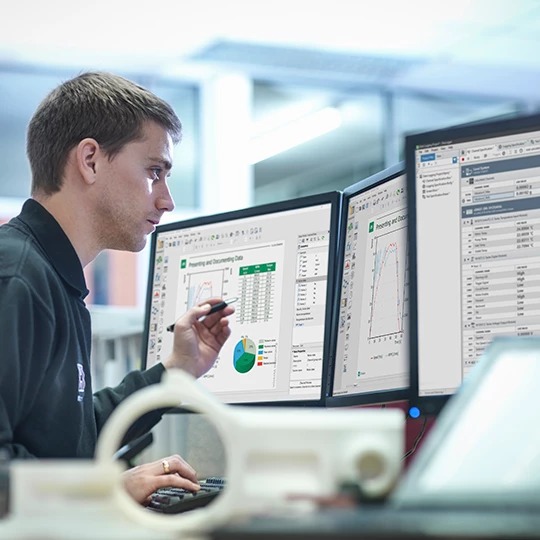LabVIEW software stands as a beacon in the realm of programmable logic controllers (PLCs), showcasing its prowess in communicating with PLCs through diverse channels. One such communication protocol that has stood the test of time is Modbus. Initially introduced by Modicon in 1979 as a serial communication protocol for PLCs, Modbus later evolved to incorporate the TCP protocol, solidifying its status as an industry standard due to its widespread availability. In this comprehensive guide, we will delve into the intricacies of utilizing LabVIEW to establish communication with a networked PLC using Modbus, with a focus on the LabVIEW Datalogging and Supervisory Control (DSC) Module.
Mastering Modbus with LabVIEW DSC Module
Creating a Modbus Master I/O Server
Embark on the journey of creating a LabVIEW interface known as an I/O Server, facilitating automatic updates of LabVIEW with real-time values from Modbus addresses. Follow these steps:
- Project Initialization
- Open LabVIEW and create a new project.
- Access the LabVIEW Project window and right-click on “My Computer.”
- Select “New»I/O Server” to initiate the creation process.
- Configuring Modbus Master I/O Server
- Choose Modbus as the desired protocol.
- From the Model drop-down menu, opt for Modbus Ethernet.
- Specify the IP Address of the target Modbus Slave.
- Save the project as “ModbusDemoProject” and the library as “ModbusDemoLibrary.”
Binding Shared Variables to Modbus Addresses
Learn the art of creating shared variables bound to Modbus addresses, enabling seamless data sharing across LabVIEW applications. Execute the following steps:
- Variable Binding
- Right-click on “ModbusDemoLibrary” and select “Create Bound Variables.”
- Navigate to the desired Modbus address range (e.g., 000001-065535) and add the range.
- Confirm the creation of a shared variable bound to the Modbus address.
- Deployment
- Deploy the shared variables by right-clicking on “ModbusDemoLibrary” and selecting “Deploy All.”
Writing to Modbus Addresses in LabVIEW
Explore the process of writing to Modbus addresses within LabVIEW, empowering you to control and manipulate data dynamically. Follow these guidelines:
- VI Creation
- Create a new VI from the Project Explorer.
- Add a push button to the Front Panel for user interaction.
- Block Diagram Wiring
- Drag and drop the shared variable to the Block Diagram.
- Set the access mode to “Write” for the shared variable.
- Connect the shared variable to the push button for data flow.
- Implementing While Loop
- Introduce a while loop to execute code continuously.
- Add a control button within the loop for user-initiated stopping.
- Timing Enhancement
- Include a Wait Until Next ms Multiple VI to regulate loop execution timing.
Monitoring Shared Variables with Distributed System Manager
Efficiently manage shared variables using the Distributed System Manager. This section guides you through the process:
- Accessing Distributed System Manager
- Select “Tools»Distributed System Manager” from the Project Explorer.
- Variable Monitoring
- Navigate to the ModbusDemoLibrary in the Variable Manager.
- Monitor shared variable values in real-time.
Bridging the Gap: Modbus Master and Slave Interaction
Viewing Shared Variables with Modbus Slave
Transition seamlessly into understanding how a Modbus Slave reads values updated by a Modbus Master. Execute the following steps:
- Modbus Simulator Initialization
- Open the NI Example Finder and select “Toolkits and Modules»Datalogging and Supervisory Control»I/O Servers.”
- Run the Modbus Simulator from the project.
- Running Modbus Master VI
- Execute the Modbus Master VI and observe the Modbus Simulator’s response.
- Analyzing Modbus Slave Interaction
- Explore the Modbus Simulator’s Block Diagram to comprehend the reading of Modbus addresses.
Elevate Your Expertise with an Extra Challenge
Mastering Modbus Relationships
Challenge yourself by enhancing your understanding of Modbus Masters and Slaves. Modify your Modbus Master program to read and control additional values in the Modbus Simulator, requiring the addition of bound Shared Variables to the Modbus I/O Server in the ModDemoProject.
Congratulations! You’ve not only harnessed the power of LabVIEW for Modbus communication but also delved into the intricate dynamics of Modbus Master and Slave interactions. This mastery opens new horizons for robust analysis and control functions in industrial applications.

